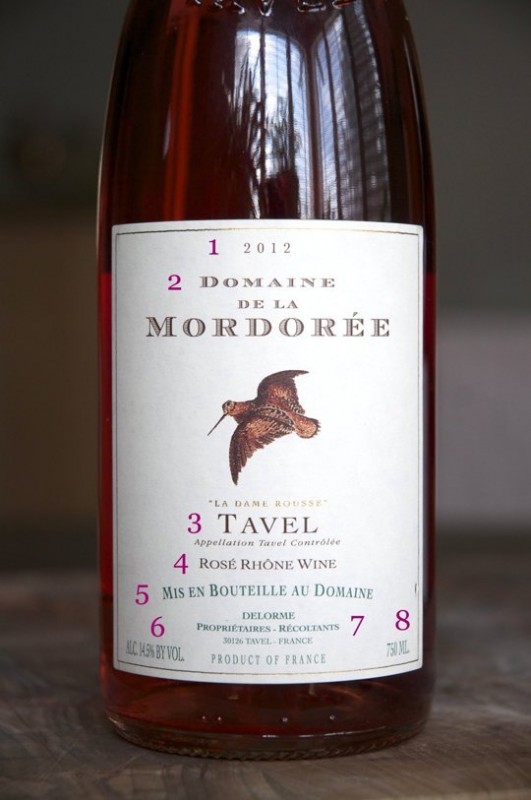
French Wine Label Basics:
1. Vintage
2. Producer
3. Appellation title or “sub-region”
4. Region and style
5. Translates as “bottled at the estate”
6. Alcohol content
7. Winery address
8. Volume
Now that we have covered the basics, let’s highlight some of France’s most prominent wine regions, the grapes grown there, and the styles of wine produced, along with specific regional phraseology.
Bordeaux
Located in the southwest corner of France, this region’s bold red blends, based around Cabernet Sauvignon and Merlot, are the benchmarks by which all other wines of this style are compared. Although there are dry and sweet white wines made primarily of Sauvignon Blanc and Sémillon, this is predominately a red wine region.
Primary Red Grapes – Cabernet Sauvignon, Merlot, Cabernet Franc, Petit Verdot, Malbec, Carmenere
General Style – full-bodied, dry, earthy red wines
The region is divided by the Gironde Estuary. The regions to the West, or “Left Bank,” of the river produce wines based upon Cabernet Sauvignon, while the regions to the East, or “Right Bank,” of the river produce wines based primarily on Merlot.
Major Left Bank Regions – Médoc, St. Julien, Pauillac, St. Estephe, Margaux, Graves, Pessac-Léognan
Major Right Bank Regions – Pomerol, St. Émilion
Burgundy
Located far inland near the eastern border of France, Burgundy is the one region equally famous for both its reds and whites. Comprised of dozens of small villages and vineyards that were sectioned off by the Cistercian monks hundreds of years ago, Burgundy is the most intricate vineyard land in the world.
Primary Grapes – Pinot Noir, Chardonnay, Gamay
General Style – elegant, light-bodied, dry reds and expressions of Chardonnay that range from steely and crisp to richly oaked.
There are five main sub-regions of Burgundy, each with its own distinct style. From North to South:
Chablis – crisp, generally un-oaked Chardonnay
Côte d’Or – further subdivided into two regions, the Côte de Nuits in the North (primarily Pinot Noir) and the Côte de Beaune in the South (primarily Chardonnay). This is where most of Burgundy’s top vineyards or grand crus are located.
Côte Chalonnaise – high quality reds and whites
Maconnais – good quality Chardonnay, most famously from Pouilly-Fuissé
Beaujolais – focused on the Gamay grape
Nowhere else in the world are single parcels and vineyards so prized as in Burgundy. The two highest levels of quality in Burgundy are based solely around single vineyard wines, emphasizing the distinct characteristics of that particular place.
Grand Cru – the 33 most famous single vineyards in Burgundy
Premier Cru (or 1er Cru) – over 500 single vineyards of exceptional quality
Village Wine – wines made from grapes surrounding a single village, where the village is actually the name of the wine (examples: Pommard, Mercurey, Rouilly, Volnay)
Bourgogne – wines made from any grapes grown anywhere in Burgundy
Alsace
Located in the far northeast corner of France, bordering Germany, this region has a long history of Germanic influence with respect to grape varietals, while the winemaking reflects a distinctively French influence. These are the easiest labels within France to understand: they are mostly labeled by grape varietal.
Primary Grapes – Riesling, Pinot Gris, Gewurztraminer, Pinot Blanc, Muscat
General Style – crisp, dry whites, with some delicious dessert wines
Alsace also utilizes a “grand cru” designation with over 50 of its top vineyards classified as such. Although most of the wines produced here are crisp, un-oaked whites, there are two tiers of high quality dessert wine, as well: Vendange Tardive and Sélection de Grains Nobles.
Rhône
Located in the southeast corner of France, the Rhône River flows through some of the country’s most diverse vineyard land on its way to the Mediterranean Sea. This is a region of extremes, from the searing hot regions in the Southern Rhône to the frigid windswept mountains of the Northern Rhône.
Primary Grapes – Syrah, Grenache, Mourvedre, Viognier
General Style – wild, gamey reds; rich, aromatic whites; and bone-dry rosés
The Rhône Valley is a tapestry of sub-regions, each with its own specific style and blending requirements. With a scorching climate, the sub-regions of the Southern Rhône are based around blending the grapes, Grenache, Syrah, and Mourvedre (GSM). The cooler temperatures of the Northern Rhône allow for single varietal wines of great purity, primarily Syrah for red and Viognier for white.
Major N. Rhône Regions – Hermitage, Cornas, Cote Rotie, Condrieu
Major S. Rhône Regions – Châteauneuf-du-Pape, Gigondas, Vacqueyras
Major Rosé-producing Regions – Tavel, Provence
Not to be confused with the Chardonnays from the Pouilly-Fuissé region of Burgundy, Pouilly-Fumé is made from Sauvignon Blanc grapes.
Loire
Located in the heart of France, the Loire is the country’s longest river. Draining from the Central Massif mountain range, the Loire river runs steadily west, passing through over fifty sub-regions on its way to the Atlantic. This is the most difficult region in France to learn, as virtually every possible style of wine is made here.
Primary Grapes – Cabernet Franc, Sauvignon Blanc, Chenin Blanc, Melon de Bourgogne
General Style – racy, herbaceous, mineral-driven reds and whites, as well as a large quantity of sparkling, sweet, and rosé wines
Similar to the Rhône region, the Loire is comprised of many sub-regions, each focusing on specific grapes and styles.
Dry, crisp Sauvignon Blanc – Sancerre, Pouilly-Fumé
Wild, savory Cabernet Franc – Chinon, Bourgueil
Fruity, dry rosés and high quality sparkling wines – Anjou-Saumur
Rich, yeasty Melon de Bourgogne – Muscadet
Dramatic Chenin Blanc, from sweet to dry – Savennieres, Vouvray
